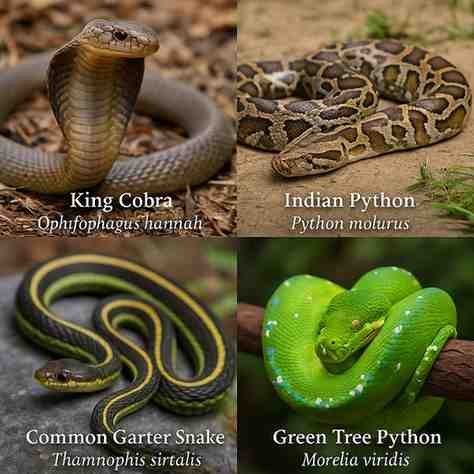What is the scientific name for a snake? A snake scientific name is Serpentes.
Snakes are some of the most interesting and diverse reptiles in the entire animal kingdom. But then, what is the scientific name for a snake? What does it mean? How is that pronounced? How are snakes classified biologically? In this article, we will explore the snake scientific name, genus, meaning, pronunciation, and biological classification of the snake. Discover the many types of snakes that can be found around the world.
Table of Contents
What Is the Scientific Name for Snake?
There is no universal scientific name for all snakes since “snake” describes more than one big group of reptiles. All snakes fall under the suborder Serpentes.
- Scientific Name (Suborder): Serpentes
- Pronunciation: (SUR-pen-teez)
- Meaning: Derives from Latin serpens, meaning “a creeping or crawling creature.”
The snake’s scientific name, Serpentes, represents all snakes in zoological classification.
Scientific Classification of Snakes
So, this is the complete biological classification of snakes:
| Taxonomic Rank | Classification |
|---|---|
| Kingdom | Animalia |
| Phylum | Chordata |
| Class | Reptilia |
| Order | Squamata |
| Suborder | Serpentes |
Common Snake Genus and Species Examples
There are thousands of species of snakes around the world, each with its genus and scientific name. Some well-known examples are:

- King Cobra
- Scientific Name: Ophiophagus hannah
- Genus: Ophiophagus
- Meaning: Snake eater
- Indian Python
- Scientific Name: Python molurus
- Genus: Python
- Common Garter Snake
- Scientific Name: Thamnophis sirtalis
- Genus: Thamnophis
- Green Tree Python
- Scientific Name: Morelia viridis
- Genus: Morelia
Types Of Snake: Scientific Name With Example
Snakes can be categorized based on venom, habitat, behavior, and anatomy. Below is a detailed breakdown:
1. Venomous Snakes
These snakes use venom to paralyze or kill their prey and may harm humans.
Examples:
- King Cobra (Ophiophagus hannah)
- Russell’s Viper (Daboia russelii)
- Coral Snake (Micrurus spp.)
- Gaboon Viper (Bitis gabonica)
2. Non-Venomous Snakes
They are not harmful to humans and often kill prey by constriction.
Examples:
- Ball Python (Python regius)
- Boa Constrictor (Boa constrictor)
- Garter Snake (Thamnophis sirtalis)
3. Constrictors
These snakes squeeze prey until it suffocates.
Examples:
- Anaconda (Eunectes murinus)
- Burmese Python (Python bivittatus)
- Boa Constrictor
4. Aquatic Snakes
Live in or around water. Some are marine and venomous.
Examples:
- Beaked Sea Snake (Hydrophis schistosus)
- Water Snake (Nerodia spp.)
- Sea Krait (Laticauda spp.)
5. Arboreal (Tree-Dwelling) Snakes
They live in trees and are skilled climbers.
Examples:
- Green Tree Python (Morelia viridis)
- Emerald Tree Boa (Corallus caninus)
- Asian Vine Snake (Ahaetulla nasuta)
6. Terrestrial Snakes
These snakes live primarily on the ground.
Examples:
Indian Cobra (Naja naja)
Corn Snake (Pantherophis guttatus)
King Snake (Lampropeltis spp.)
7. Fossorial (Burrowing) Snakes
Live underground or beneath leaf litter.
Examples:
- Blind Snake (Indotyphlops braminus)
- Sand Boa (Eryx spp.)
- Thread Snake
8. Desert Snakes
Adapted to hot, arid climates with sandy terrain.
Examples:
- Sidewinder Rattlesnake (Crotalus cerastes)
- Horned Viper (Cerastes cerastes)
- Rosy Boa (Lichanura trivirgata)
9. Colubrid Snakes
The largest snake family with mostly non-venomous species.
Examples:
- Milk Snake (Lampropeltis triangulum)
- Boomslang (Dispholidus typus)
- Rat Snake (Pantherophis spp.)
Snake Types Summary Table
| Types of Snakes | Habitat Type | Venomous? |
|---|---|---|
| Cobra, Viper, Coral Snake | Land, Forest | Yes |
| Garter, Python, Rat Snake | Land, Forest | No |
| Boa, Anaconda, Python | Land, Water | No |
| Sea Snake, Water Snake | Ocean, Freshwater | Some |
| Tree Python, Vine Snake | Trees | Varies |
| Cobra, Corn Snake, King Snake | Ground | Varies |
| Blind Snake, Sand Boa | Underground | Rarely |
| Sidewinder, Horned Viper | Desert | Often |
| Milk Snake, Boomslang, Rat Snake | Various | Mostly No |
Final Thoughts on Snake Scientific Name
In simple words, Serpentes, the scientific name of the snake, represents an extensive and varied group of reptiles. Whichever form a snake takes, venomous or non-venomous, aquatic or arboreal, it has a role to play within the ecosystem of the world. Understanding their classification, meaning, pronunciation, and kinds helps us appreciate their diversity.

